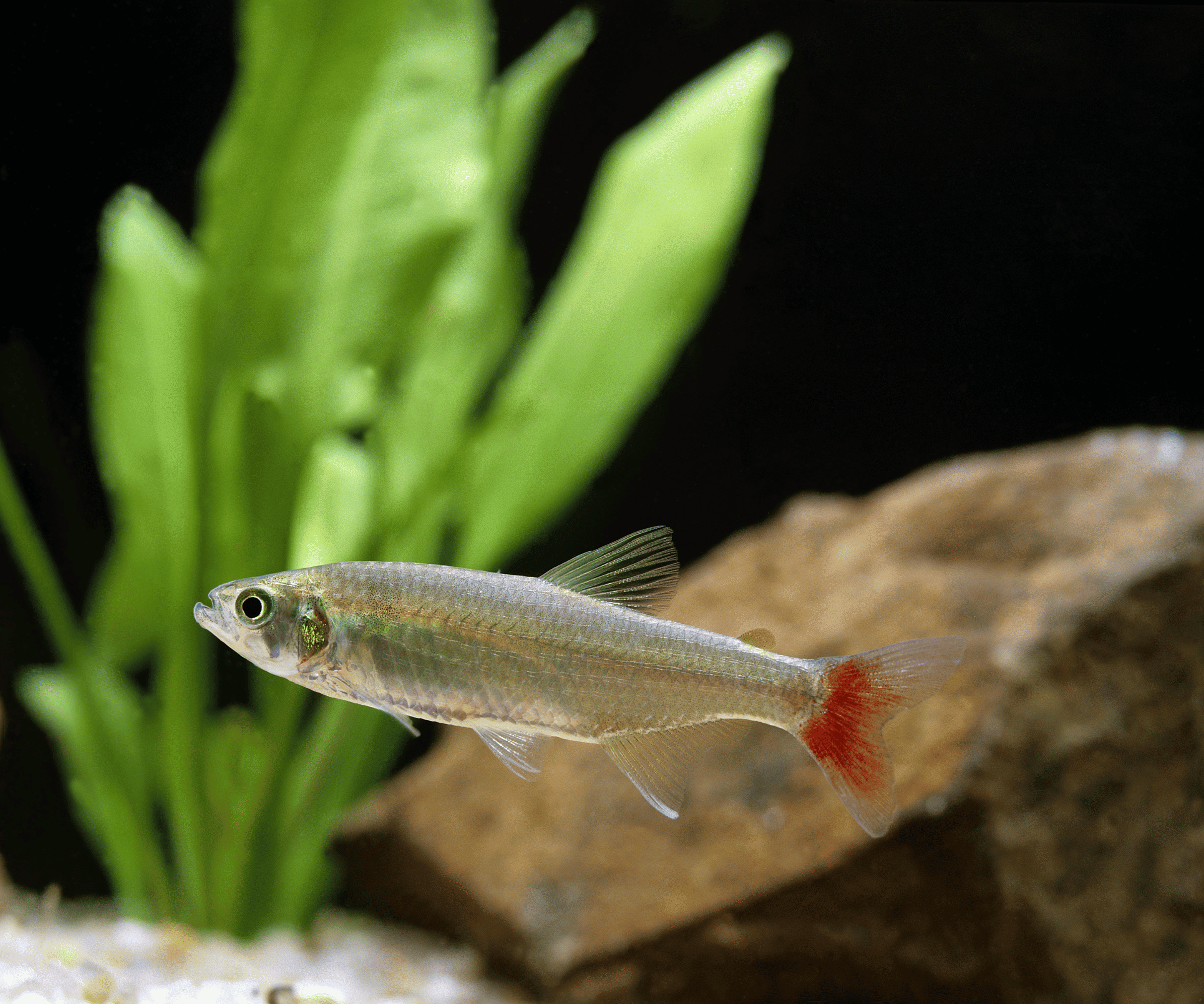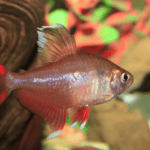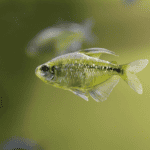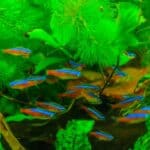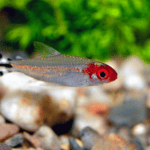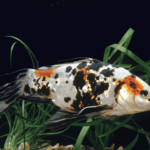Have you ever been mesmerized by the vibrant red fins and shimmering silver scales of a Bloodfin Tetra? These fascinating fish capture our hearts with their unique appearance and playful behavior. If you’re considering adding Bloodfin Tetras to your aquarium, you’re in for an exciting journey! In this comprehensive guide, we will delve into everything you need to know about Bloodfin Tetra care, from their origins and physical features to their social dynamics, breeding, and health.
Short Summary
- Bloodfin Tetras are stunning, peaceful fish that thrive in a well-maintained aquarium.
- Creating an ideal environment with the right tank setup, diet and compatible tank mates encourages natural schooling behavior and helps to avoid potential conflicts.
- Breeding Bloodfin Tetras is easy and rewarding when preventative measures such as quarantining new fish are taken for their continued good health.
Bloodfin Tetra Basics
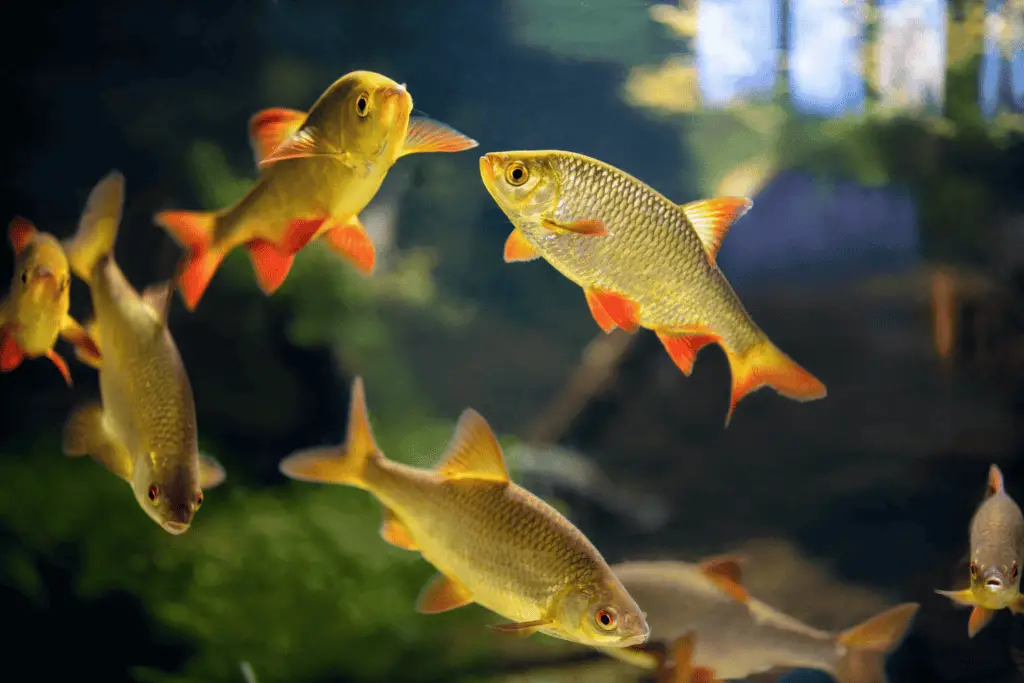
Bloodfin Tetras (Aphyocharax anisitsi) are small, slim-bodied fish that hail from the captivating Paraná River basin in South America. These elegant swimmers stand out in any aquarium due to their stunning silver scales and the eye-catching red hue on their anal and tail fins. They prefer the upper to mid-layers of the water, making them a lively addition to any community tank.
These marvelous fish belong to the Aphyocharax genus and are known for their peaceful and social nature. Bloodfin Tetras are schooling fish, meaning they thrive in groups and enjoy exploring their environment together. With a full-grown size of just over 2 inches, they are the perfect choice for hobbyists looking for smaller fish to add some vibrant color and movement to their aquarium.
Natural Habitat
In their natural habitat, Bloodfin Tetras inhabit slow-moving rivers and streams with acidic waters and lush vegetation. These picturesque environments provide the perfect backdrop for these active swimmers.
In the wild, they consume a diverse diet of crustaceans, small insects, and worms. When setting up your aquarium, it’s essential to replicate this environment to ensure your Bloodfin Tetras feel right at home.
Physical Features
Bloodfin Tetras are truly a sight to behold. Their torpedo-like shape and dazzling silver scales create an alluring appearance, while the vibrant red color on their dorsal, anal, adipose, and tail fins sets them apart from other aquarium fish.
The males tend to be more vibrant, whereas females display a more subtle red and a fuller body, especially during breeding times. These fish typically range from 1 1/2 to 2 inches in length, with some reaching an impressive 2 1/4 inches.
Males and females have distinct characteristics, making it easy to distinguish between the sexes. Males feature striking red anal and tail fins, while females exhibit a more subtle red hue on anal fins, and tend to be more plump around breeding time.
Caring for Your Bloodfin Tetra
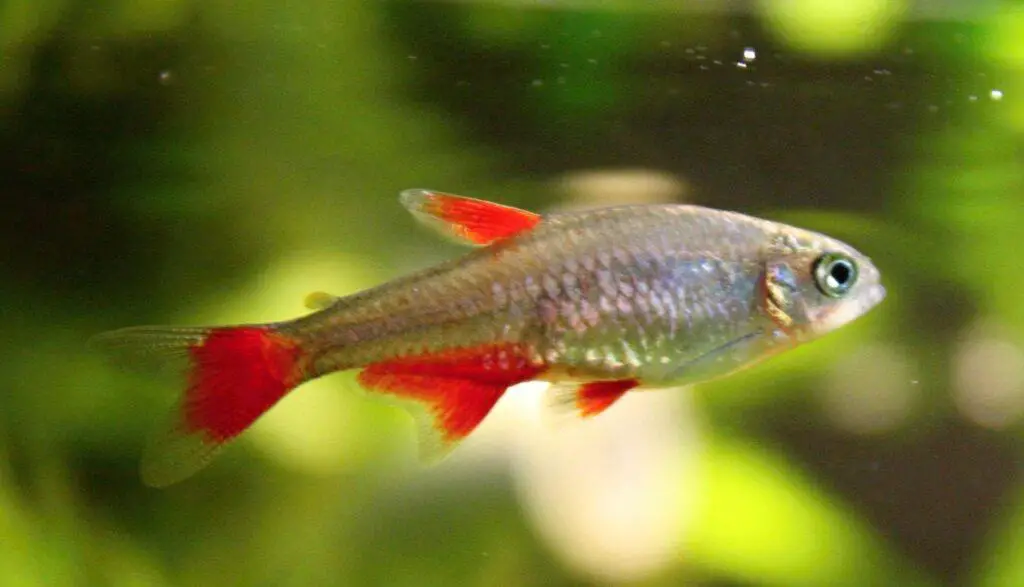
Proper care for Bloodfin Tetras involves providing them with an appropriate tank setup, a comfortable environment, and a balanced diet to ensure they thrive.
In this section, we will discuss the tank requirements, how to create a comfortable environment, and the nutritional needs of these fascinating fish.
Tank Requirements
To replicate the South American river environment that Bloodfin Tetras call home, it is essential to ensure your tank meets their specific requirements. A minimum tank size of 30 gallons is recommended, giving them ample space to swim and explore. A dark sand substrate, live plants, and artificial hideouts can be used to create a natural-looking habitat.
A sturdy lid is necessary, as these fish are known to be active jumpers. The tank should be equipped with an efficient filter, such as a standard canister filter, to maintain water quality. Although a heater is not always necessary, it can be beneficial in maintaining a consistent water temperature above room temperature. Bloodfin Tetras prefer water temperatures between 70-80°F (21.11-26.67°C).
Creating a Comfortable Environment
Bloodfin Tetras enjoy slow to moderate-moving water, making it essential to provide a suitable flow rate in your tank. A darker substrate, such as dark gravel or river sand, can help replicate their natural environment and make them feel more at ease. Dim lighting or blacklight can also be used to create a natural river environment for your Bloodfin Tetras.
In addition to the substrate and lighting, it is crucial to add plenty of plants and hiding places for your Bloodfin Tetras. Java Moss, broadleaf Anubias, and narrow leaf Anacharis are excellent plant choices that can help create a vibrant and comfortable habitat for these fish. Providing a variety of hiding spots, such as driftwood, rocks, twisted roots, and dried leaves, will help your Bloodfin Tetras feel secure and content in their new home.
Proper Nutrition
As omnivores, Bloodfin Tetras require a varied diet to ensure they receive all the necessary nutrients. They should be fed commercial flakes or pellets, supplemented with high-protein snacks such as brine shrimp, bloodworms, tubifex worms, and daphnia.
Providing a balanced and nutritious diet will help keep your Bloodfin Tetras healthy and thriving in their aquarium environment.
Social Dynamics & Tank Mates
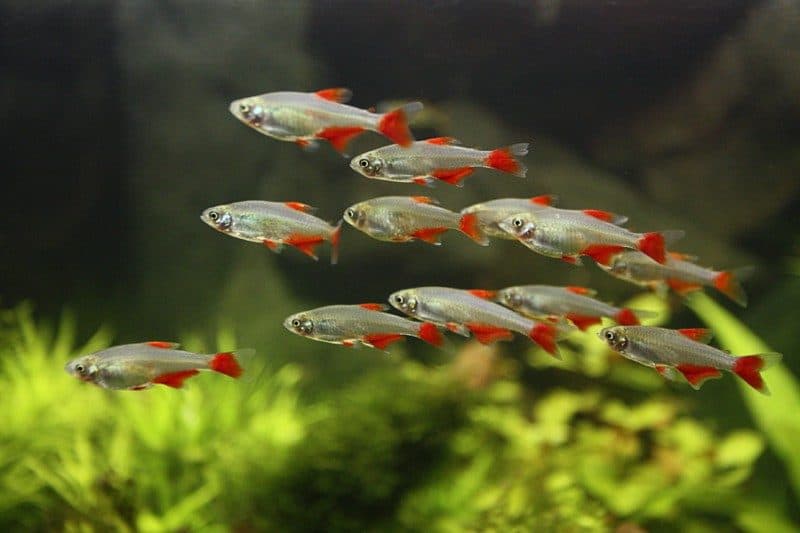
Bloodfin Tetras are social creatures that thrive in groups and prefer the top and middle part of the same tank together. They are fast swimmers and tend to nip at slow tank mates, so it’s essential to carefully consider their companions.
In this section, we will discuss their schooling behavior, suitable tank mates, and potential conflicts that may arise when keeping Bloodfin Tetras in a community tank.
Schooling Behavior
Bloodfin Tetras do best in groups of 5 to 7 fish, and they do well with other similarly-sized fish species. Keeping them in a group not only brings out their natural social behaviors, but also helps reduce stress and promote a more harmonious environment in your tank.
It is best to avoid large and aggressive fish that may intimidate or harm your Bloodfin Tetras.
Suitable Tank Mates
Ideal tankmates for Bloodfin Tetras include other peaceful fish species such as Corydoras, Danios, Loricariids, Platy, Rasbora, Shrimp, Snails, and Swordtails.
Bloodfin Tetras may show small signs of aggression within their group and have been known to nip at the fins of Guppies and Angelfish. It’s essential to monitor their behavior and ensure that all tank inhabitants coexist peacefully.
Potential Conflicts
Although Bloodfin Tetras are generally peaceful fish, it is crucial to keep an eye on their behavior and interactions with other tank inhabitants. If one Bloodfin Tetra is exhibiting bossier behavior than the others, it could be beneficial to remove it from the tank to help maintain the peace and harmony of the group.
Ensuring that your Bloodfin Tetras have enough space and hiding places can also help reduce the risk of conflicts and stress.
Breeding Bloodfin Tetras
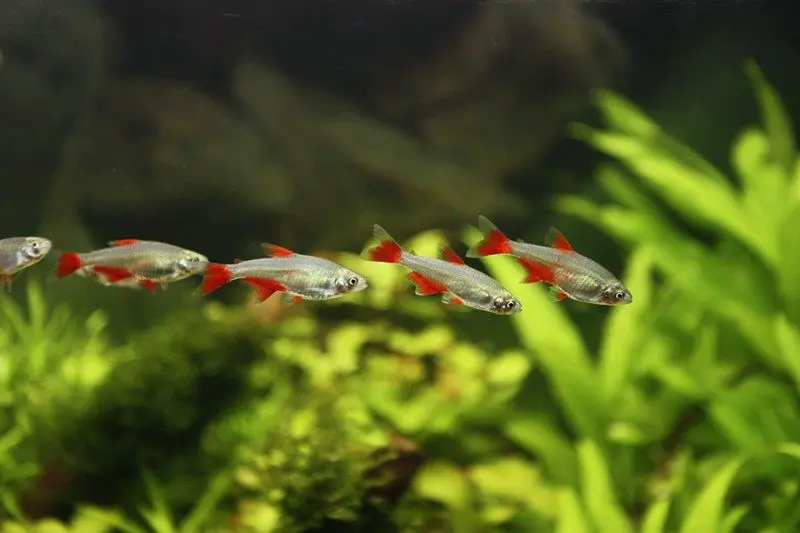
If you’re interested in breeding Bloodfin Tetras, you’ll be pleased to know that it’s a relatively simple process. In this section, we’ll discuss how to prepare for breeding, the spawning process, and how to raise the fry to adulthood.
Preparing for Breeding
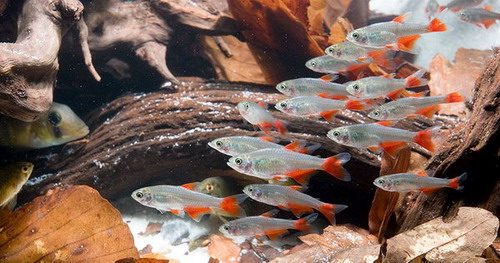
To begin the breeding process, you’ll first need to set up a separate breeding tank with soft water, bushy plants or breeding mops, and a sponge filter for optimal filtration. It’s essential to provide the fish with a protein-rich diet to encourage spawning, and once the fish have naturally paired off, you can introduce them to the breeding tank.
After the female lays her eggs, which can number up to 500, the adult female fish should be removed from the tank to prevent them from eating the eggs.
Spawning Process
The spawning process for Bloodfin Tetras is relatively easy. The eggs will hatch in just a few days, and the fry will not require any feeding initially as they will still be consuming their yolk sacs.
Once the yolk sacs that lay eggs are depleted, you can begin feeding the fry with liquid fry food and gradually introduce baby brine shrimp as they grow larger.
Raising Fry
Raising Bloodfin Tetra fry is not a difficult task, but it does require some attention to detail. It’s important to frequently change the water in the breeding tank and carefully monitor water parameters to ensure optimal conditions for the fry’s growth and development.
As the fry grows, you can gradually introduce powdered fry food and small live foods such as brine shrimp, daphnia, and microworms. Providing a balanced and nutritious diet will help the fry grow strong and healthy, eventually becoming beautiful adult Bloodfin Tetras.
Health & Disease Prevention
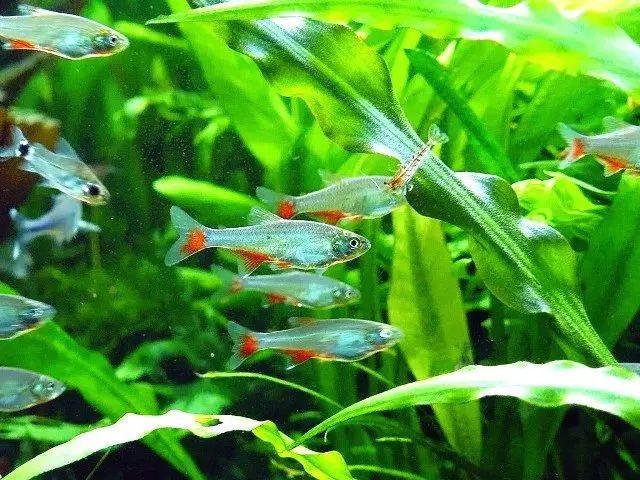
Bloodfin Tetras are hardy and healthy fish, but like any aquatic creature, they need proper care to prevent illness and ensure a long, happy life.
In this section, we will discuss the signs of illness in Bloodfin Tetras, preventative measures to keep them healthy, and available treatment options for common diseases.
Signs of Illness
It’s essential to regularly monitor your Bloodfin Tetras for any signs of illness. Indications of poor health may include lethargy, loss of appetite, discoloration, and clamped fins.
If you notice any of these symptoms, it’s crucial to take action and address the issue promptly to prevent further health complications.
Preventative Measures
One of the best ways to prevent disease in your Bloodfin Tetras is to quarantine any new fish before introducing them to the main tank. This helps to ensure that any potential illnesses or parasites are not inadvertently introduced to your established aquarium community. Regular water changes and proper tank maintenance are also crucial in keeping your Bloodfin Tetras healthy and preventing the spread of disease.
Another key aspect of disease prevention is providing your Bloodfin Tetras with a balanced and nutritious diet. A healthy diet will help boost their immune system and ensure they have the energy and strength to fight off any potential illnesses.
Treatment Options
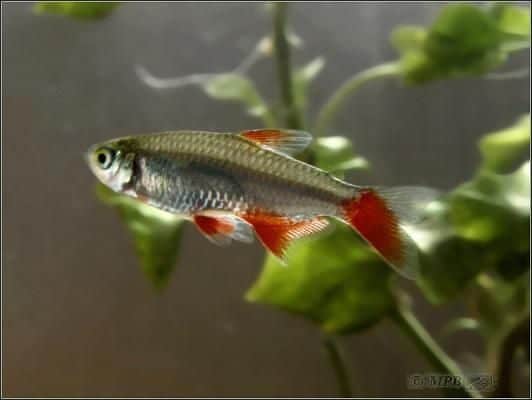
If your Bloodfin Tetras do fall ill, there are a variety of treatment options available to help them recover. Over-the-counter medications can be used to treat common parasites, while antibiotics such as enrofloxacin and erythromycin may be prescribed for bacterial infections.
In the case of nutritional deficiencies, vitamin supplements can be used to ensure your Bloodfin Tetras receive all the necessary nutrients for optimal health.
Summary
In conclusion, Bloodfin Tetras are a beautiful and engaging addition to any aquarium. With their unique red fins and playful personalities, they will undoubtedly bring joy to any fish enthusiast. By providing them with the proper care, suitable tankmates, and a balanced diet, you can ensure that your Bloodfin Tetras thrive in their aquatic environment. Whether you’re a seasoned aquarist or just starting your fishkeeping journey, these fascinating tropical fish will captivate your heart and inspire a lifelong passion for the aquatic world.
Frequently Asked Questions
Can Bloodfin Tetra live alone?
While it is possible to keep a single Bloodfin Tetra in a tank, it’s not recommended due to the fish’s social nature. To give them the best environment for growth and health, consider getting a group of at least five fish and setting up a tank of at least 20 gallons.
This will help them to be happiest and healthiest!
Are Bloodfin tetras cold water fish?
Yes, Bloodfin tetras can survive in cold water, but they prefer warmer temperatures of 70-80 degrees Fahrenheit. With the right care and tank setup, these small but beautiful fish can thrive even in cold water tanks with cooler temperatures.
So if you’re looking for a cold water fish, bloodfin tetras are an excellent choice!
